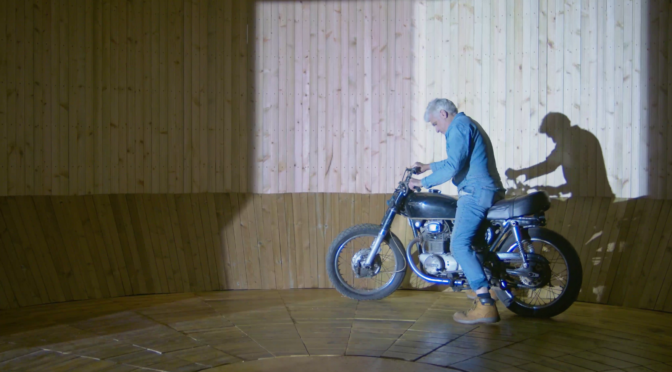 THE ARTIST AND THE WALL OF DEATH is an Irish-Scottish co-production that follows Glasgow-based visual artist Stephen Skrynka in his obsessive quest to build a Wall of Death. The documentary centres on failure in an interesting way, but the perfunctory treatment of that failure and the actual human cost behind it lets the film down.
THE ARTIST AND THE WALL OF DEATH is an Irish-Scottish co-production that follows Glasgow-based visual artist Stephen Skrynka in his obsessive quest to build a Wall of Death. The documentary centres on failure in an interesting way, but the perfunctory treatment of that failure and the actual human cost behind it lets the film down.
Stephen Skrynka is a visual artist primarily working on glass sculpture and large-scale performance installation pieces. The film is peppered throughout with some of his film pieces and clips of his performances which he says often involve picking up other people’s trades. Stephen is obsessed with the Wall of Death, a fairground stunt attraction inside which a motorcyclist drives around the wall of a wooden cylinder, held to the surface by centripetal force. He describes the stunt as an artform in itself: “Something that looked so smooth and graceful and easy. And yet totally and utterly impossible.” One of his preoccupations is bringing this artform to a different audience; one of people who go to the ballet or the opera rather than fairground stunt shows. Stephen and the film will continue to draw this strong distinction between the audience for modern performance art and the masses.
With National Theatre of Scotland support, Stephen stages Wall of Death: A Way of Life, in which he exhibits pieces reflecting on the Wall of Death, stages a Wall of Death stunt with the Ken Fox Troupe, and shows videos of his attempts to learn to ride the Wall. These videos largely reflect his continual failures in training: falling off the wall, skipping into a pile with the bikes, and being berated for his inability to follow instructions. Stephen and the documentary’s directory, Maurice O’Brien, are not afraid to showcase failure.
The theme of failure becomes more prominent in Stephen’s next endeavour: tracking down the real-life inspirations of the Irish film EAT THE PEACH, directed by Peter Ormrod. This fiction film tells the story of two men building their Wall of Death in the middle of the Irish countryside. Though Stephen finds the real-life inspirations, Michael Donohoe and Connie Kiernan, he discovers that the Wall never brought them the income or popularity they hoped for. The documentary reflects on failure as a core part of being human, even more so than success. We see people failing and falling and learning something nonetheless.
Unfortunately, as the documentary continues, failure becomes just another component in an overarching narrative rather than a serious concept to be reckoned with. As Stephen drives a wedge between himself and his collaborators in his pursuit of a high-brow audience, his failure to sustain working relationships is glossed over in a cut to 18 months later. The documentary positions this failure as a narrative low point before a dramatic return to emotional highs in the climax but only ever alludes to the human costs of that failure rather than adequately interrogating them. It seems as if neither O’Brien as director nor Stephen as documentary subject want to focus on those actual costs of failure, and it’s a shame because the theme of failure has such potency for a documentary film. THE ARTIST AND THE WALL OF DEATH ends up with a rather traditional narrative trajectory that doesn’t get to the root of the importance of failure in creativity.

